标签:config dad actor list objects targe ext 文件 定义
上篇我学习了Spring.net的四种通知类型,AOP的实现方案比较复杂,是通过代码实现的。而Spring.NET框架给我们提供了配置的方式来实现AOP的功能。到目前为止,我们已经讨论过使用ProxyFactoryObject或其它类似的工厂对象显式创建AOP代理的方法。如果应用程序需要创建很多AOP代理,比如当需要代理某个服务层的所有对象时,这种方法就会使配置文件变的相当庞大。为简化配置过程,Spring.NET提供了“自动代理”的功能,可以根据条件自动创建代理对象,也就是说,可以将多个对象分组以作为要代理的候选对象。自动代理使用起来比较简单和方便。我仔细分析了一下,提供的几种配置差异主要在于切入点的方式不同。目前我实现了三种切入点的配置方式。
首先我们先来看一下准备环境。
通知
public class AroundAdvice : IMethodInterceptor
{
public object Invoke(IMethodInvocation invocation)
{
Console.WriteLine("开始:" + invocation.TargetType.Name + "." + invocation.Method.Name);
object result = invocation.Proceed();
Console.WriteLine("结束:" + invocation.TargetType.Name + "." + invocation.Method.Name);
return result;
}
}
目标对象
public interface IService
{
IList FindAll();
void Save(object entity);
}
public class CategoryService : IService
{
public IList FindAll()
{
return new ArrayList();
}
public void Save(object entity)
{
Console.WriteLine("保存:" + entity);
}
}
public class ProductService : IService
{
public IList FindAll()
{
return new ArrayList();
}
public void Save(object entity)
{
Console.WriteLine("保存:" + entity);
}
}
一、对象名称切入点:ObjectNameAutoProxyCreator
ObjectNameAutoProxyCreator可以用特定的文本值或通配符匹配目标对象的名称,并为满足条件的目标对象创建AOP代理。该类支持模式匹配字符串,如:"*name","name*",”*name*“和精确文本如"name"。我们可以通过下面这个简单的例子了解一下自动代理的功能。
App.config
<object id="ProxyCreator" type="Spring.Aop.Framework.AutoProxy.ObjectNameAutoProxyCreator, Spring.Aop">
<property name="ObjectNames">
<list>
<value>*Service</value>
</list>
</property>
<property name="InterceptorNames">
<list>
<value>aroundAdvice</value>
</list>
</property>
</object>
<object id="aroundAdvice" type="Common.AroundAdvice, Common"/>
<object id="categoryService" type="Service.ProductService, Service"/>
<object id="productService" type="Service.ProductService, Service"/>
Program
class Program
{
static void Main(string[] args)
{
IApplicationContext ctx = ContextReGIStry.GetContext();
IDictionary speakerDictionary = ctx.GetObjectsOfType(typeof(IService));
foreach (DictionaryEntry entry in speakerDictionary)
{
string name = (string)entry.Key;
IService service = (IService)entry.Value;
Console.WriteLine(name + " 拦截: ");
service.FindAll();
Console.WriteLine();
service.Save("数据");
Console.WriteLine();
}
Console.ReadLine();
}
}
输出效果:
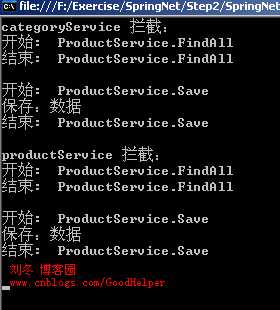
图1
使用ObjectNameAutoProxyCreator经常需要对要拦截的方法进行筛选,这时我用到Spring.Aop.Support.NameMatchMethodPointcutAdvisor,稍微修改一下配置:
App.config
<object id="ProxyCreator" type="Spring.Aop.Framework.AutoProxy.ObjectNameAutoProxyCreator, Spring.Aop">
<property name="ObjectNames">
<list>
<value>*Service</value>
</list>
</property>
<property name="InterceptorNames">
<list>
<value>aroundAdvisor</value>
</list>
</property>
</object>
<object id="aroundAdvisor" type="Spring.Aop.Support.NameMatchMethodPointcutAdvisor, Spring.Aop">
<property name="Advice" ref="aroundAdvice"/>
<property name="MappedNames">
<list>
<value>Find*</value>
</list>
</property>
</object>
<object id="aroundAdvice" type="Common.AroundAdvice, Common"/>
输出效果
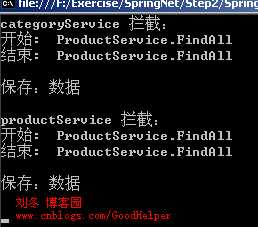
图2
MappedNames的配置为:Find*,因此能够拦截到FindAll方法。
二、正则表达式切入点:RegularExpressionMethodPointcutAdvisor和SdkRegularExpressionMethodPointcut
DefaultAdvisorAutoProxyCreator类会在当前容器中自动应用满足条件的Advisor,而不用在自动代理Advisor的对象定义中包含特定的对象名。它既可以保持配置文件的一致性,又可避免ObjectNameAutoProxyCreator引起的配置文件的臃肿。
先来说RegularExpressionMethodPointcutAdvisor。
App.config
<object id="aroundAdvisor" type="Spring.Aop.Support.RegularExpressionMethodPointcutAdvisor, Spring.Aop">
<property name="advice" ref="aroundAdvice"/>
<property name="patterns">
<list>
<value>.*Find*.*</value>
</list>
</property>
</object>
<!--必须让Spring.net容器管理DefaultAdvisorAutoProxyCreator类-->
<object id="ProxyCreator" type="Spring.Aop.Framework.AutoProxy.DefaultAdvisorAutoProxyCreator, Spring.Aop"/>
<object id="aroundAdvice" type="Common.AroundAdvice, Common"/>
<object id="categoryService" type="Service.ProductService, Service"/>
<object id="productService" type="Service.ProductService, Service"/>
输出效果:
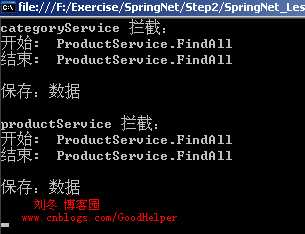
图3
以上配置相对复杂一点。使用SdkRegularExpressionMethodPointcut的配置就相对简单的多,而项目中SdkRegularExpressionMethodPointcut也经常用到。
SdkRegularExpressionMethodPointcut只需要简单的配置一下通知和切入点就完成了。
App.config
<object id="advisor" type="Spring.Aop.Support.SdkRegularExpressionMethodPointcut, Spring.Aop">
<property name="pattern" value="Service.*"/>
</object>
<aop:config>
<aop:advisor pointcut-ref="advisor" advice-ref="aroundAdvice"/>
</aop:config>
<object id="aroundAdvice" type="Common.AroundAdvice, Common"/>
<object id="categoryService" type="Service.ProductService, Service"/>
<object id="productService" type="Service.ProductService, Service"/>
输出效果:
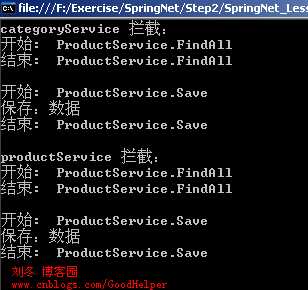
图4
pattern属性为拦截表达式。Service.*的意思是,拦截Service命名空间下(包括子空间)的所有类。如果改为Service.*.Find*",意思为拦截Service命名空间下(包括子空间)的所有类以Find开头的方法或Service命名空间下以Find开头的所有类输出效果:
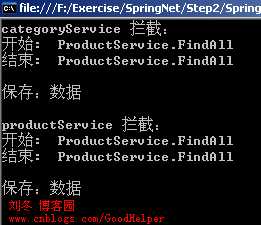
图5
三、属性切入点:AttributeMatchMethodPointcutAdvisor
Spring.net框架运行开发人员自定义属性,拦截标注带有特定属性的类中的方法。
Attribute
public class ConsoleDebugAttribute : Attribute
{
}
public class AttributeService : IService
{
[ConsoleDebug]
public IList FindAll()
{
return new ArrayList();
}
public void Save(object entity)
{
Console.WriteLine("保存:" + entity);
}
}
App.config
<object id="aroundAdvisor" type="Spring.Aop.Support.AttributeMatchMethodPointcutAdvisor, Spring.Aop">
<property name="Advice" ref="aroundAdvice"/>
<property name="Attribute"
value="ConfigAttribute.Attributes.ConsoleDebugAttribute, ConfigAttribute" />
</object>
<object id="proxyFactoryObject" type="Spring.Aop.Framework.ProxyFactoryObject">
<property name="Target">
<object type="ConfigAttribute.Service.AttributeService, ConfigAttribute" />
</property>
<property name="InterceptorNames">
<list>
<value>aroundAdvisor</value>
</list>
</property>
</object>
<object id="aroundAdvice" type="Common.AroundAdvice, Common"/>
输出效果:
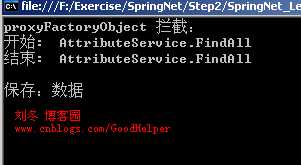
图6
标签:config dad actor list objects targe ext 文件 定义
原文地址:https://www.cnblogs.com/lzhdim/p/9910117.html